IT service management (ITSM) has experienced tremendous growth in the wake of the COVID-19 pandemic, which has spurred on the rapid development of a number of IT operations (ITOps) and digital transformation initiatives.
According to a recent report by Global Industry Analysts, the ITSM global market is projected to reach USD $5 billion by 2026, growing at a CAGR of 8.9%—up from USD $3 billion in 2020. This growth is driven by a number of factors, including enterprises moving to hybrid digital infrastructures. These infrastructures require IT managers to oversee an increasing array of operational processes while ITSM vendors continue to differentiate themselves with advanced ITSM capabilities to incorporate business workflows, analytics, artificial intelligence (AI), virtual agents, chatbots, machine learning (ML), and greater ease of use.
Table of Contents
What is ITSM Software?
ITSM is a set of software, tools, and approaches utilized by ITOps managers and leaders to better manage the workflows and tasks that underpin the delivery of IT services. These tasks include IT service and help desks and oversight of enterprise IT operations and infrastructures, all of which is aimed at providing comprehensive enterprise IT management while increasing productivity and efficiency, reducing operational costs, and improving the customer experience and satisfaction.
Also read: Implementing IT Service Management Changes with CloudOps
How Do You Choose an ITSM Tool?
Here are key features to consider when choosing ITSM tools and software:
- Incident Management: Many types of incidents can occur in IT. Some are vitally important, while many are not. Incident management should be able to help IT identify priorities with automation features that simplify the process.
- Problem Management: Problem management assists IT via processes and activities that manage the lifecycle of problems that could happen in an IT service. The purpose is to prevent problems from happening and resolve incidents rapidly.
- Change Management: The number of changes taking place within the IT infrastructure can be confusing. If they are not tracked, a great many challenges are likely to result. For example, if a server virtualization project is initiated without detailing all the processes, services, storage connections, and dependencies involved, chaos could erupt. The latest change management modules sometimes provide risk analysis to highlight potential issues in advance.
- Service Asset/Configuration Management: Service asset and configuration management is all about maintaining an accurate record of all information about the many configuration items (CIs) required to deliver an IT service as well as their dependencies and relationships.
- Service Desk: A service desk provides a point of contact to ensure users receive help for requests that can vary from the routine to full-blown emergencies.
- Analytics: These days, data is no longer allowed to be locked inside an ITSM system. It is shared with external systems, and ITSM gains data from a great many sources across the enterprise to aid in achieving its core functions more rapidly and with a greater level of automation. Sharing of information enables advanced analytics related either for ITSM or for broader business management purposes.
- Extension Beyond IT: There are so many ITSM solutions out there that it takes additional functionality to stand out. Some offer intelligent search, chatbots, improved routing, automation recommendations, various types of analysis, support for complex processes, AI/ML, support for containers, and serverless computing. But more than that, ITSM capabilities are being extended beyond the traditional technology services (request, incident, problem, and change management) to areas of the enterprise such as facilities, fleet management, and HR.
Top ITSM Tools and Vendors
Based on the trends outlined in aforementioned reports and interviews with vendors, we have compiled a list of the leading ITSM solutions, with additional guidance for verticals like managed service providers (MSPs) and small businesses. Here are our picks for top ITSM software.
BMC Helix

BMC Software has arranged its ITSM suite in alignment with IT Infrastructure Library (ITIL) best practices. The BMC Helix Suite includes modules for chatbot, digital workplace, discovery, ITSM, business workflows, and cloud-native microservices. It also comes with built-in AI and ML capabilities. Users can choose to deploy it on-premises, SaaS, multi-cloud, and hybrid. Its ITSM module can run on a choice of public clouds (AWS, Azure, IBM, BMC).
Key Differentiators
- Incident Management: Create and resolve incidents faster with intelligent, context-aware, and proactive incident matching.
- Problem Management: ITIL 4-compliant best practices for service management processes that embed mature practices into the user experience and back-end workflow.
- Change Management: Simplified change request processes with a guided process on mobile and web, drag-and-drop change calendar, and automated and contextual collision detection and impact analysis.
- Service Asset/Configuration Management: Scalable, service view configuration management for IT operations management (ITOM). Offers class structure, data and service models, federation, reconciliation and normalization, and agentless application and dependency mapping.
- Service Desk: Support a variety of service request workloads at scale, such as customer service in large banks.
- Analytics: BMC Helix ITSM has cognitive capabilities that automate classification, assignment, and routing of incidents as well as provides cognitive email analysis and response.
- Extension Beyond IT: Ability to track operating level agreements and contracts from external providers. It also extends to HR, facilities, and procurement.
- Market Strength: BMC has the largest enterprise installed base for core ITSM services. Not aimed at the SME market.
- Pricing: BMC offers a free trial with enterprise pricing available upon request.
Ivanti Neurons for ITSM
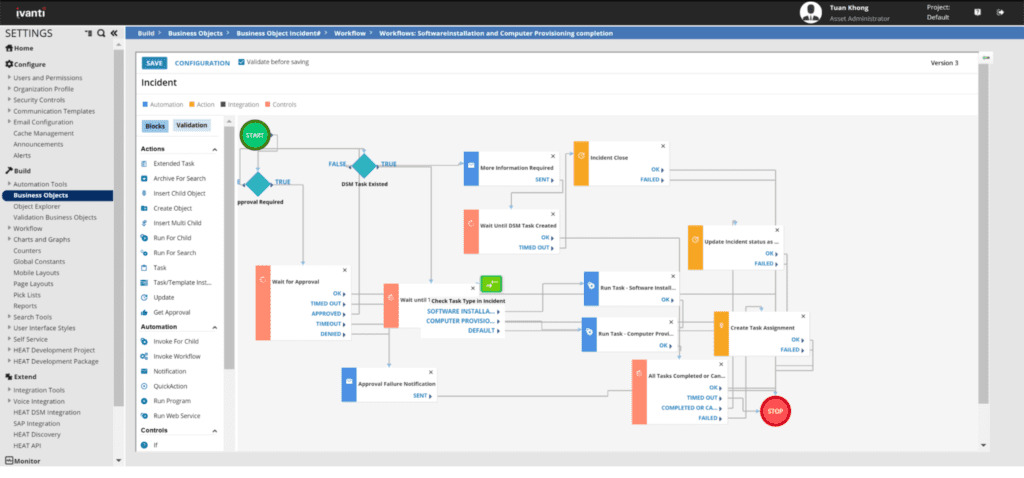
Ivanti Neurons for ITSM is a three-tiered cloud-optimized, scalable ITSM solution for automating workflows. The company’s Foundational tier offers easy-to-use incident management for dealing with inbound ticket requests; followed by the addition of the Intermediate tier to provide change and configuration management for IT service desk and ITOps; and rounds out with the Comprehensive tier to add greater management—including service level, financial, portfolio, and project management among others.
Key Differentiators
- Incident Management: Ivanti provides fast, flexible incident management including analytics to deal with inbound ticket requests from any channel.
- Problem Management: Problem management utilizes information from other elements within the enterprise for automated problem resolution processes.
- Change Management: Ivanti offers user configurable support of change workflow and business processes and enough flexibility to modify or create new change workflows.
- Service Asset/Configuration Management: Service asset and configuration management enable the handling of IT changes quickly and efficiently.
- Service Desk: Ivanti was the original service desk solution in the 1980s. It includes dashboards, reporting, knowledge management, mobility, self service, and more.
- Analytics: Review events over selected time periods, track mean time between failure (MTBF) for assets and services, and report service availability against service-level agreements.
- Extension Beyond IT: Ivanti tracks external providers’ operating level agreements and the underpinning contracts.
- Market Strength: Ideal for organizations looking for a single solution to synchronize IP telephony/PBX and ITSM. Strong in healthcare, higher education, manufacturing, retail, and legal.
- Pricing: Ivanti offers a free cloud trial, while price quotes are provided by call or email.
EasyVista Service Manager
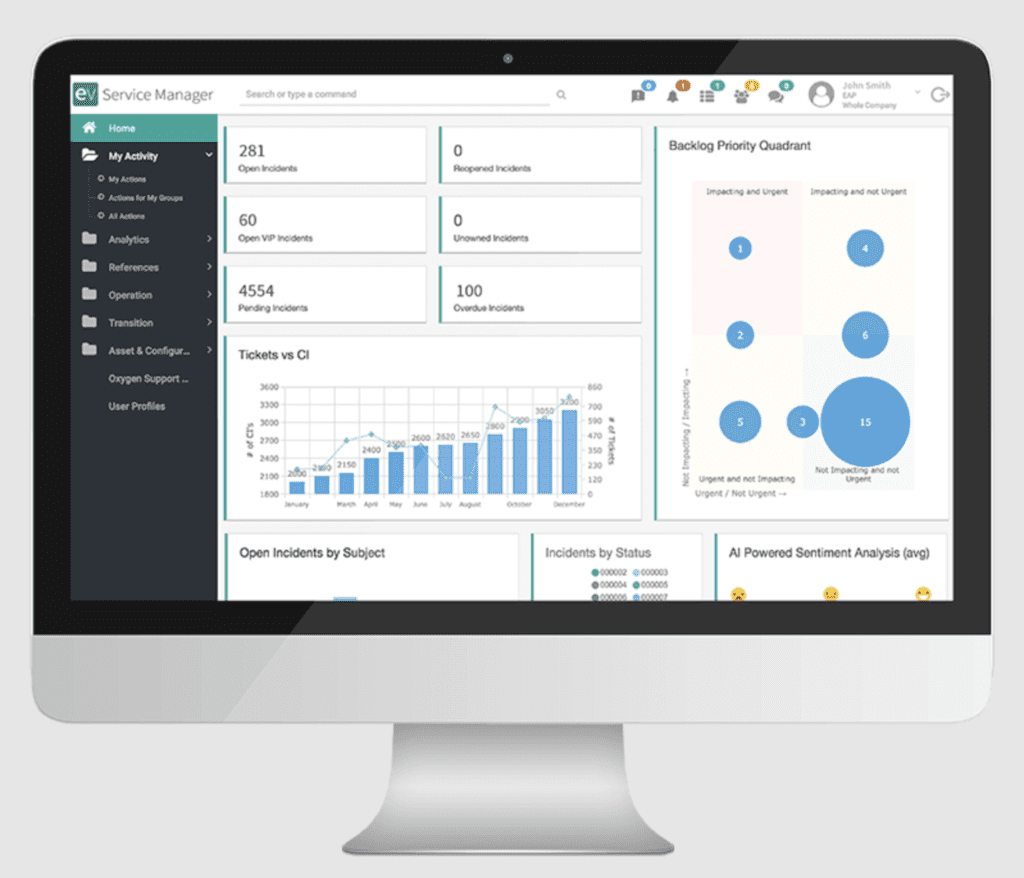
The EasyVista Enterprise Service Management Platform includes ITSM, Enterprise Process Automation (service manager), Advanced Intelligent Knowledge Management (self help), and Micro Apps technology (for building apps, portals, and dashboards). It is available as SaaS and on-premises.
Key Differentiators
- Incident Management: Automatic knowledge search locates any related known errors, knowledge articles, news, or major incidents. Resolutions from knowledge can be copied to current incidents.
- Problem Management: Alerts can be received from third-party monitoring tools, analyzed, and can trigger events such as a simple recording of the events, a notification, or the creation of an incident.
- Change Management: Changes are categorized based on change catalog records that also define the related workflow. Impact analysis lets you understand the impact of a change based on the CMDB relationship.
- Service Asset/Configuration Management: Assets and configuration items (CIs) are linked to define the dependency map. Business services are tracked and linked to CIs.
- Service Desk: Request management starts with the service catalog. Workflows are configured and associated with every service.
- Analytics: Microsoft Cognitive Services are used to interpret user needs.
- Extension Beyond IT: EasyVista Service Manager is used to support the offering and delivery of various enterprise services such as IT, HR, and facilities.
- Market Strength: EasyVista is primarily focused on the small and medium-size enterprise (SME) market with many customers in the public sector, education, healthcare, and insurance. It is strongest in the European market.
- Pricing: EasyVista offers a free demo with pricing provided on request.
CA Clarity Service Manager
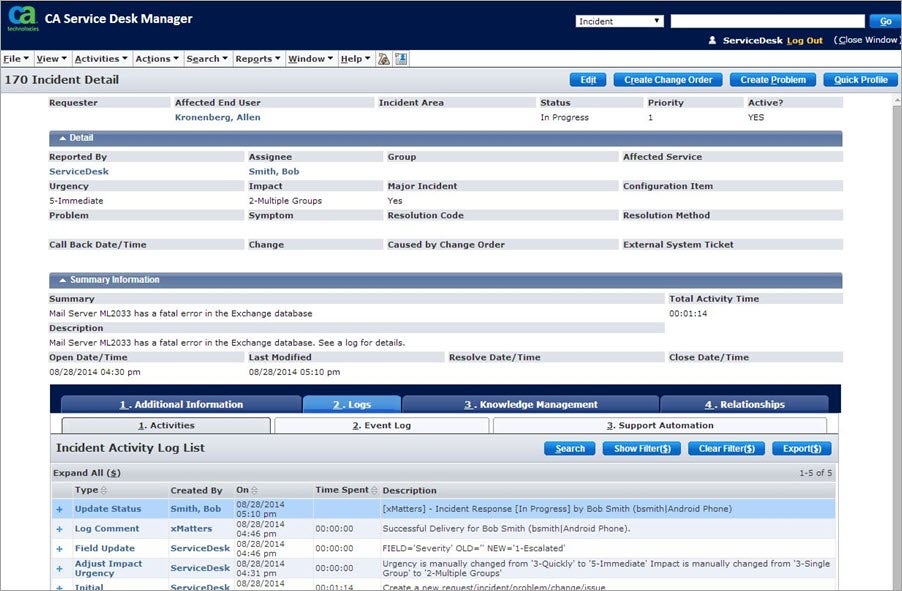
CA Technologies (now owned by Broadcom) is a veteran of the ITSM market. Its ITSM solution, known as Clarity Service Manager, offers intelligent search, chatbots, improved routing, automation, sentiment analysis, and image analysis. It includes a variety of service workflows and is particularly strong on analytics, work prioritization, knowledge management, portal development, mobile capabilities, and camera support. In addition, ML aids in queue awareness and automatic categorization of incidents and requests.
This ITSM tool is on-premises only and part of a larger suite, which includes additional products. Its multi-tenancy approach makes it popular among MSPs.
Key Differentiators
- Incident Management: Incident generation can be automated through integrations with email systems, command line interfaces, web services, event monitoring, and CTI tools.
- Problem Management: You can create a standalone problem, a problem from an incident, and attach an incident to a problem. You can also select the impacted CI.
- Change Management: CA Technologies includes a robust CMDB and integrations between the service desk and Clarity Configuration Automation, Clarity Service Operations Insight, and Clarity Client Automation.
- Service asset/configuration Management: Integration between Clarity APM and Clarity SM enables sharing of business-critical information to form a view of assets and CIs.
- Service Desk: Mobility and collaborative self-service bring users together to share information and resolve issues on their favorite devices, often without opening a ticket.
- Analytics: xFlow gives analysts the ability to understand the complete state of the IT environment, a way to prioritize work, and the context to make decisions.
- Extension Beyond IT: Users have begun to leverage it for a variety of use cases, such as HR, procurement, and facilities.
- Market Strength: CA Technologies has traction with MSPs that use the product to service many hundreds of clients. Overall, it is primarily a large enterprise solution.
- Pricing: Contact sales for software and hardware pricing.
Micro Focus Service Management Automation X

Micro Focus SMAX is a single suite for ITSM, enterprise service management, and IT asset management. It incorporates containers and Kubernetes to decrease ticket volumes as well as automated service support for IT and non-IT processes, workflows, and tasks based on ML and analytics. It can be run in the cloud (AWS, Azure, Google) or on-premises or consumed as a service. It drives change management by using prescriptive analytics to decrease change failures and reduce service outages.
SMAX has codeless configuration and can help develop new applications without developer skills. A self-service portal comes with social collaboration as the single point of contact for business and IT users for support and requests. Intelligent search, chatbots, and a strong CMDB are included.
Key Differentiators
- Incident Management: Restore normal service operation, access incidents from the landing page, automate reporting and track incidents, and issue alerts or escalate an incident.
- Problem Management: Identify the underlying reasons for one or more related incidents, enabling IT teams to create workarounds, identify known errors and define solutions.
- Change Management: Create and manage requests for change to the service assets and configured items registered in the CMDB by providing templates and change models to implement changes.
- Service Asset/Configuration Management: SMAX helps you organize and track the individual assets that support business services.
- Service Desk: The service desk is a centralized location for all employee issues related to IT. Its interface enables users to independently request support, search a self-help knowledge base, and browse a service catalog.
- Analytics: SMAX comes with an embedded Micro Focus IDOL Intelligent Data Operating Layer, which allows for the search and processing of text taken from both structured data and unstructured human information.
- Extension Beyond IT: Micro Focus SMAX includes enterprise service management features to extend ITSM to other business services.
- Market Strength: Micro Focus SMAX is primarily aimed at large-scale environments with higher process maturity and strong regulatory compliance reporting and audit requirements.
- Pricing: In addition to a 14-day free trial, Micro Focus offers pricing on request.
SolarWinds IT Service Desk
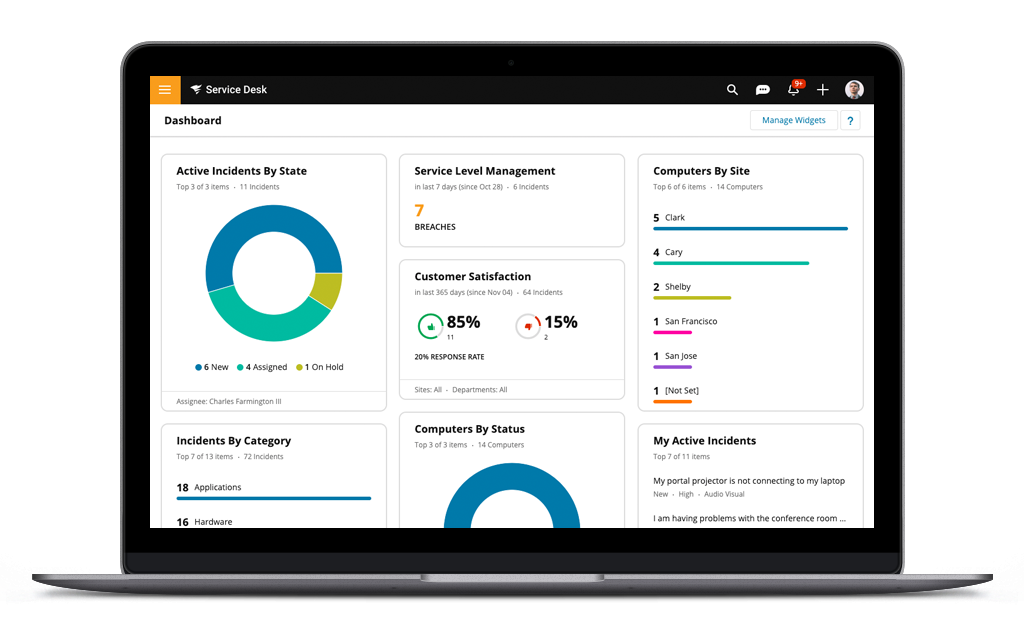
Solarwinds’ IT Service Desk management software is an ITSM solution that offers incident management, standardized service request and fulfillment processes, change management, fully integrated IT asset management, and more. The platform also integrates with 200 cloud applications.
Key Differenciators
- Incident Management: Resolve incidents and reduce or eliminate simple tasks. Automated rules are in place for ticket routing and priority.
- Problem Management: Trending helps uncover problems. View the status of a problem impacting users. Agents can search open problems to see if there is a known issue causing their incidents to be opened.
- Change Management: ITIL change management processes include clear communication to the people affected while improving service quality and consistency across operations.
- Service Asset/Configuration Management: The CMDB contains an organization’s users, services, physical assets, hardware, and software to build the upstream and downstream relationship of configuration items.
- Service Desk: The service desk gives employees the ability to submit tickets and requests and gives agents a tool where they can provide services with consistency.
- Analytics: A reports module has commonly used metrics built in. Integration with Google Analytics measures service portal usage.
- Extension Beyond IT: Service Desk offers procurement.
- Market Strength: Solarwinds’ IT Service Desk has market strength in industries such as education, government, retail, and healthcare as well as SMEs.
- Pricing: On a per month basis, small teams can get started for $19, growing teams at $39, mature IT organizations at $69, and full customization for enterprises begins at $89.
InvGate Service Desk
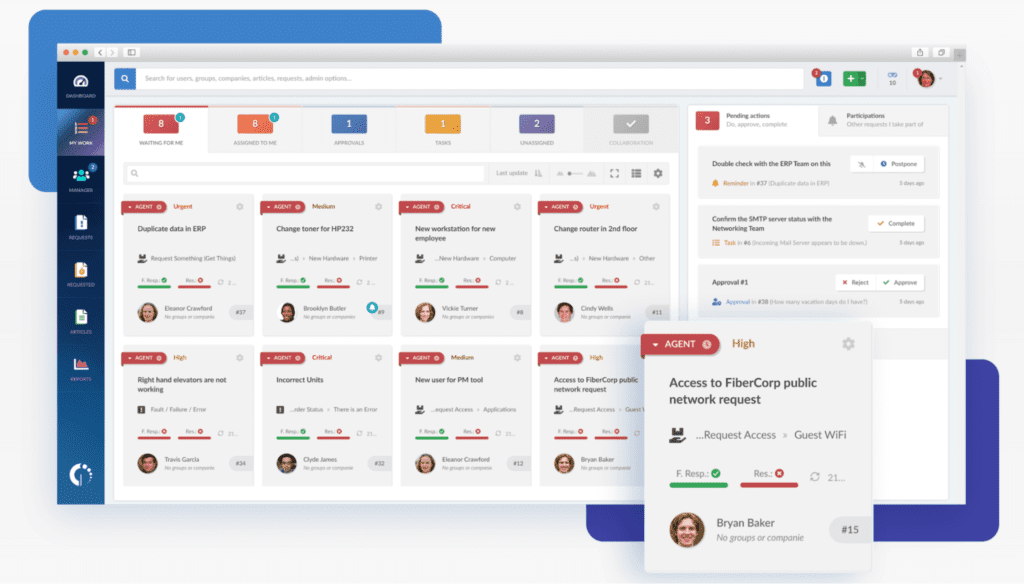
The InvGate suite is designed to provide full IT management covering service, support, discovery, monitoring, and mapping. InvGate Insight allows you to map all of the infrastructure in a single platform, as it brings together asset data and information from across all of the organization’s technology domains. This includes AWS and Azure cloud instances along with IoT devices. Any network monitoring solution can be integrated easily.
A tasks module allows automization of work to be done in a request or in the execution of a workflow, so all the necessary efforts to find a solution are divided. A knowledge management system will help to organize relevant information for it to be available at all times. As end users create a new self-service request, InvGate Natural Language Technology employs heuristics to analyze their text to suggest articles in real time. Integration with other InvGate tools allows discovery and monitoring of IT assets and management of changes. InvGate Service Desk can be integrated with third-party asset managers, such as FileWave and Microsoft SCCM. It is available as SaaS or on-premises.
Key Diferentiators
- Incident Management: InvGate PinkVERIFY-certified incident management capabilities ensure IT support can focus on what’s most important across all the tickets in front of them.
- Problem Management: Reduce the impact of repeat issues, known errors, and known problems with workflows and automation with the aim of speeding up problem identification, logging, investigation, and root cause analysis.
- Change Management: Change models can be created based on the level of risk and impact associated with different change types. Those with minimal risk and impact can be pre-approved as service requests.
- Service Asset/Configuration Management: One application contains all service modules (including service, incident, problem, and change). There is also a fully integrated CMDB (InvGate Insight) to assist with discovery of assets.
- Service Desk: Automate, manage, and measure all types of requests through a ticketing system that includes self-service capabilities.
- Analytics: The integrated OLAP approach delivers data in real time with over 150 built-in metrics.
- Extension Beyond IT: The visual workflow engine allows integration of IT operations with business processes for other business functions or departments beyond IT.
- Market Strength: The InvGate suite is strongest in LATAM (especially Argentina) and U.S. mid-market, primarily.
- Pricing: The platform is offered in three tiers—Insight, Service Desk, and Assets—with pricing proved on request.
SysAid ITSM
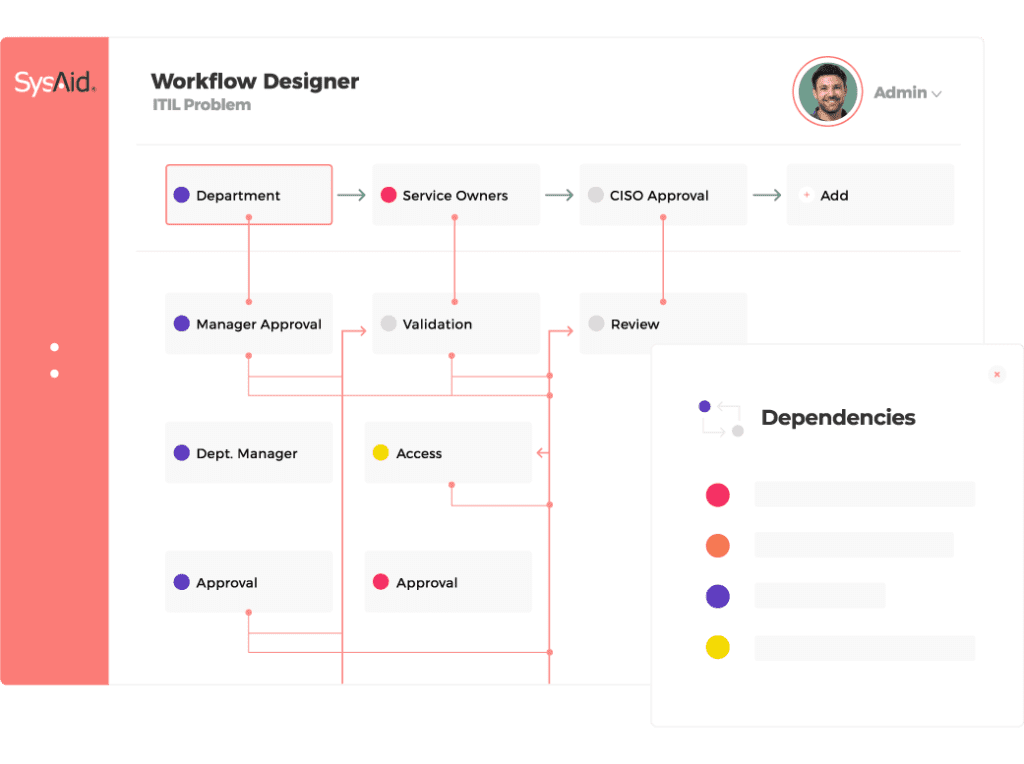
SysAid has built in an all-in-one ITSM solution, driven by automation, analytics, and AI to identify and predict issues and problems and offer up the most likely resolution. This integrated ITSM, service desk, and help desk package includes easy-to-use tools for analyzing and optimizing IT performance and automates manually intensive processes.
The company boasts over 10,000 customers in over 140 countries. SysAid can be used in the cloud or on-premises, and users can move between the two as circumstances change.
Key Differentiators
- Incident Management: SysAid ITSM’s ITIL-aligned incident management capabilities log, process, manage, and report on issues that adversely affect end users, IT services, and business services.
- Problem Management: SysAid’s problem management capabilities allow you to systemize the problem management workflow processes needed for dealing with simple and complex problems.
- Change Management: Assess the risk of every change in advance, and use an approval process to ensure all changes are in line with policy and business strategies.
- Service Asset/Configuration Management: Components include real asset management, network discovery, monitoring, mobile device management, and patch management.
- Service Desk/Help Desk: SysAid Help Desk offers a ticket management tool, IT asset management, self-service, mobile device management, chat, password reset, mobile apps, and industry benchmarking.
- Analytics: Offers analytics tools such as BI Analytics (by Qlik), reporting tools, and SysAid IT Benchmark.
- Extension Beyond IT: SysAid is primarily focused on IT services.
- Market Strength: SysAid’s market strength is very strong in education with features such as password reset (can be allowed for staff or students or both); a self-service portal to book a room or equipment; Hotkey with SSO to ensure proper logging of the request user who submitted the incident or request along with the correct asset and where it is located; and back-end service desk automation, such as routing by campus, school, or building and prioritizing by staff and administration versus students.
- Pricing: In addition to a free trial, SysAid offers pricing on request.
LogMeIn GoToAssist Service Desk
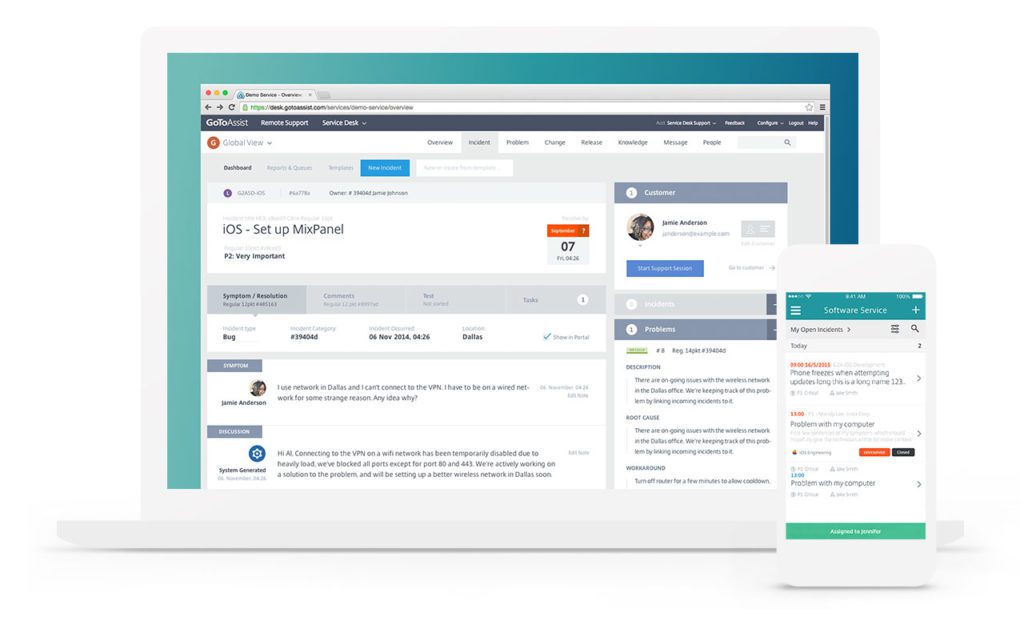
LogMeIn GoToAssist Service Desk can be custom integrated by API with ITOM systems. It is also closely integrated with the LogMeIn RescueAssist Remote Support product to help agents become more efficient by starting remote support sessions directly from a ticket. It is aligned with ITIL best practices and includes ticketing and incident management, configuration management, problem management, knowledge management, change management, contacts management, release management, a knowledge base, messaging, an online help desk, and email integration.
Service Desk is a SaaS product with popularity among MSPs. It is quick and easy to set up and can be customized to suit a particular environment.
Key Differentiators
- Incident Management: GoToAssist Service Desk covers the full spectrum of ITIL with dedicated modules. Incident management is one of the primary components and is structured by queues.
- Problem Management: Track all related incidents, root cause, or temporary workaround of problems in one place.
- Change Management: It includes tracking of change plans, builds, and test results well as approval flow and scheduling.
- Service Asset/Configuration Management: GoToAssist Service Desk has a configuration management module where individual CI types can be created: CIs can have their own attributes, categories, and relationship types.
- Service Desk: Service Desk capabilities in the incident module enable admins to create branded customer portals, build escalation flows, and set up templates for frequent request types.
- Analytics: GoToAssist includes built-in reporting to track incoming volume, agent performance, or customer satisfaction.
- Extension Beyond IT: GoToAssist is squarely based on IT services, not other services.
- Market Strength: It is popular amongst SMEs as well as MSPs.
- Pricing: The monthly price per agent is $69 (paid yearly) / $55 (paid monthly) with no limit to the number of customers or tickets created. Service Desk offers named or concurrent license types as well.
Atlassian Jira Service Desk
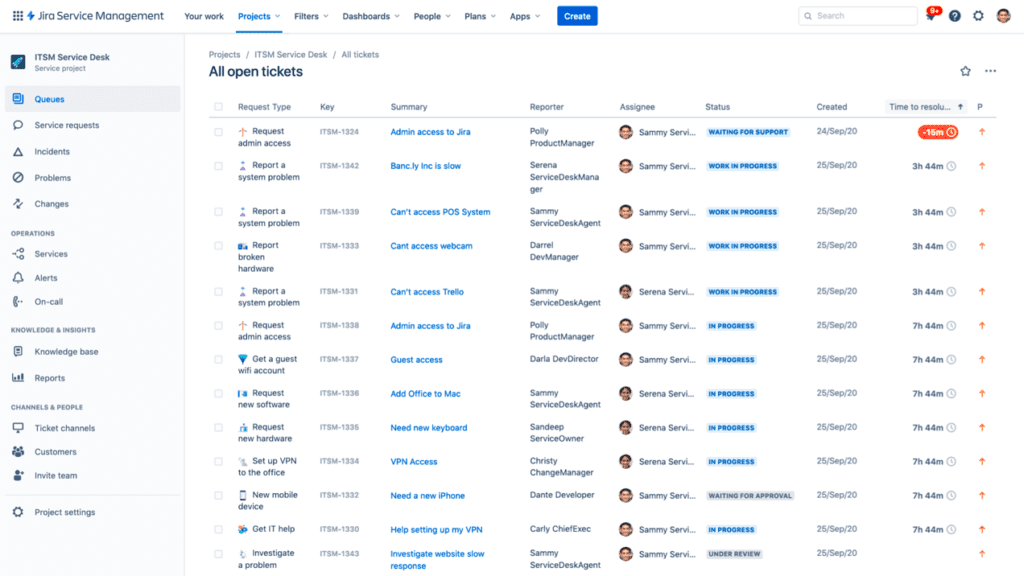
Jira Service Desk adjusts to existing workflows and agents to provide service. It emphasizes low touch and comes with stock reports, including created versus resolved, time to resolution, SLA met versus breached, and resolution by component. It offers integration with analytics tools from business intelligence (BI) to Google Analytics.
Jira Service Desk can be used as a standalone ITSM tool or part of the Atlassian suite for DevOps, which includes Jira Software, Bitbucket, Confluence, Opsgenie, and Statuspage. Confluence, for example, is a collaborative document management and storage app where you can create a knowledge base of articles that appear in your web portal. It is available as a SaaS, self-managed single server option or by Atlassian’s self-managed enterprise version.
As a relatively new platform, it still lacks some of the features of its more mature competitors. It also requires third-party CMDB and reporting tools.
Key Differentiators
- Incident Management: The Atlassian incident management solution is Opsgenie for operating always-on services, empowering DevOps teams to plan for service disruptions and stay in control during incidents.
- Problem Management: An ITIL problem management workflow investigates, records, and prevents infrastructure problems.
- Change Management: Jira takes a lean approach without compromising compliance or increasing risk to the business. It integrates with several other asset/CMDB management apps.
- Service Asset/Configuration Management: Jira Service Desk provides asset management via integrations from Oomnitza, Device42, and Riada.
- Service Desk: Jira Service Desk is a help desk request tracker. It lets you receive, track, manage, and resolve requests. The app comes with a self-service web portal.
- Analytics: Real-time reporting is available, so users can see performance metrics and workload trends.
- Extension Beyond IT: Jira Service Desk offers capabilities in HR, finance, legal, facilities, and marketing.
- Market Strength: Jira’s market strength is focused primarily on existing Atlassian customers and those heavily committed to DevOps and Agile methodologies.
- Pricing: Jira Service Desk is free for up to three agents followed by three additional tiers that range from $20 per agent up to an annually priced Enterprise tier that offers pricing on request.
ServiceNow ITSM
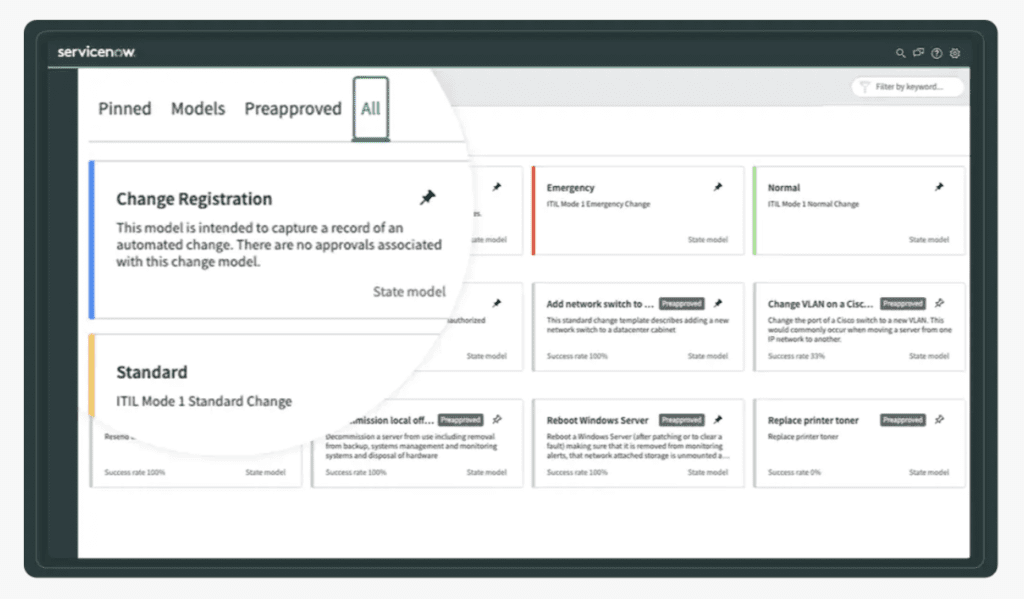
ServiceNow’s ITSM product is a part of IT Workflows on the Now Platform. IT Workflows includes modules for ITSM, ITOM, IT business management, IT asset management, DevOps, security operations, GRC (governance, risk, and compliance), and Build Your Own Apps. ServiceNow’s ITOM integrates with other monitoring tools, cloud platforms, serverless infrastructure, and asset management software including AWS, Azure, IBM Cloud, VMWare, AppDynamics, and ForeScout.
ServiceNow’s full suite of ITSM capabilities include discovery, service mapping, operational intelligence, cloud management, and orchestration. Users leverage the ServiceNow Platform to automate incident, problem, change, configuration, and request management with an out-of-the-box, codeless, pre-configured ITIL-based solution. It is a cloud-based solution with no on-premises configurations. That being said, it boasts a user community of 160,000 online members.
Key Differentiators
- Incident Management: ServiceNow connects users with IT through mobile self-service and virtual agents, leverages ML to automatically route incidents, and uses workflows to resolve issues quickly.
- Problem Management: Its problem management minimizes the business impact of service disruptions and reduces future disruptions using ITIL practices.
- Change Management: With ServiceNow Change and Release Management, companies control IT change processes, from creation, risk‑assessment, conflict detection, and approval to environmental changes.
- Service Asset/Configuration Management: The ServiceNow CMDB provides a single system of record for IT. When paired with ServiceNow Service Mapping, the CMDB enables applications to be service-aware.
- Service Desk: ServiceNow’s agent intelligence offering provides ML solutions for the automated categorization, routing, and other classification of data on the platform.
- Analytics: ServiceNow Performance Analytics is an integrated application designed for reporting and analyzing business performance.
- Extension Beyond IT: Now Platform delivers a digital workplace that brings together IT service management, ITOM, and IT business management to create contextual workflows and digitize business processes.
- Market Strength: ServiceNow focuses on enterprise and commercial accounts with at least 500 employees.
- Pricing: Subscription licensing in a SaaS deployment model hosted in ServiceNow’s private cloud.
Axios Assyst

Axios Assyst offers integration to cloud/SaaS services, auto-population of the CMDB, and comprehensive coverage of ITIL/ITSM processes. It includes multiple business service modules (HR, finance, and facilities), ML, workload allocation, and risk analytics as well as Amazon cloud integration.
Service desk tools help front-line staff route and resolve issues. ITSM, ITOM, and IT business management (ITBM) are provided in one app to give visibility and control over services, support, assets, and financials.
Key Differentiators
- Incident Management: Axios Assyst includes self-logging of incidents and requests, direct access to services and status information, and the ability to search and crowd-source knowledge via web and mobile.
- Problem Management: Automatically detect and resolve endpoint security and performance issues, reducing the flow of incidents to the service desk and making it easy to find the root cause.
- Change Management: Automated categorization and routing means incidents and requests are pushed to the right team or automated process to fit with rapid changes in business demand.
- Service Asset/Configuration Management: Axios Assyst offers a service-oriented view of the infrastructure, configuration, status, and history as well as a consumer-style service catalog.
- Service Desk: Smart technology combined with easy integration gives service desk analysts the visibility, insight, and control they need to diagnose and resolve issues.
- Analytics: The InfoZone virtual agent assistant is integrated into the logging form to push relevant information and suggested actions to analysts in real time.
- Extension Beyond IT: Axios Assyst is also used for a variety of non-IT use cases, including fleet management, legal services, and marketing.
- Market Strength: Axios Assyst has a strong presence in the U.K. and other parts of Europe.
- Cost: No pricing is provided.
IBM ITSM
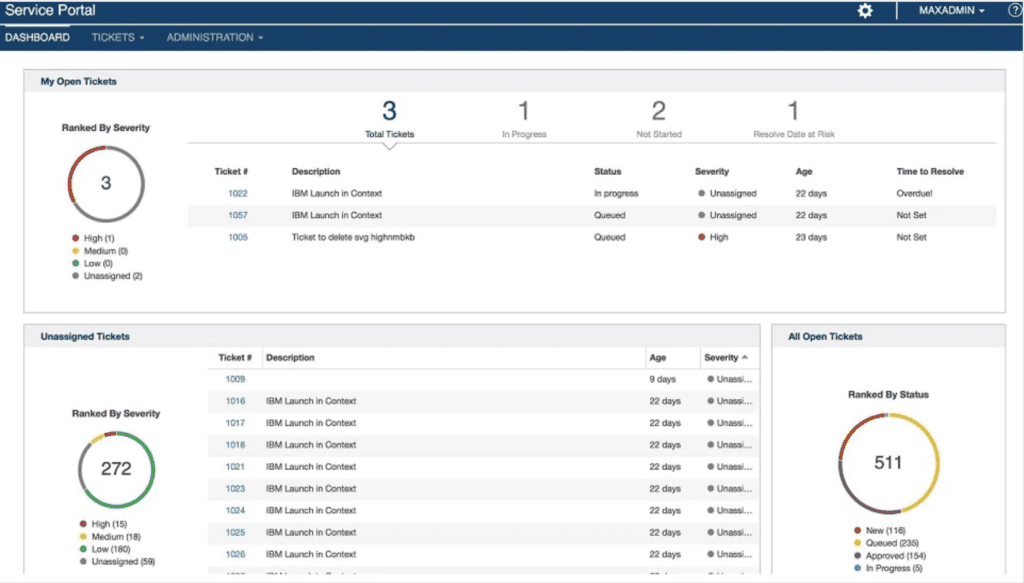
IBM considers ITSM as part of its middleware portfolio, where it isn’t given that much attention. A series of home-grown and acquired assets such as Maximo have tasked IBM with combining various ITSM or related applications such as Tivoli Process Automation Engine, Netcool, Maximo, and others. These tools provide end-to-end visibility, control, and automation to help IT operations staff manage business applications and services on-premises and in the cloud.
While IBM has a mighty arsenal of ITSM-related tools, the emphasis is on enterprise asset management and field service. Forrester said IBM Control Desk with Maximo has a configurable low/no-code platform that is scalable and includes a chatbot and reporting. However, the company gives little emphasis to this product line. As a result, it gets lost within a sprawling software catalog.
Key Differentiators
- Incident Management: IBM ITSM consolidates, reduces, and prioritizes the events and alarms that impact business services before they affect end users.
- Problem Management: It lowers the number of generated events into a small subset of actionable problems.
- Change Management: Automation helps track the status of assets and changes in near-real time.
- Service Asset/Configuration Management: IBM ITSM offers full visibility and control of all CIs and their dependencies.
- Service Desk: Automate service requests through end user catalogs, with each request handled without human interaction.
- Analytics: IBM ITSM integrates with IBM Watson AI for analytics capabilities.
- Extension Beyond IT: IBM ITSM requires personnel skilled in IBM middleware to extend it to other areas.
- Market Strength: IBM ITSM’s market strength lies in existing IBM customers who need ITSM capabilities added.
- Cost: Not available.
Freshworks Freshservice
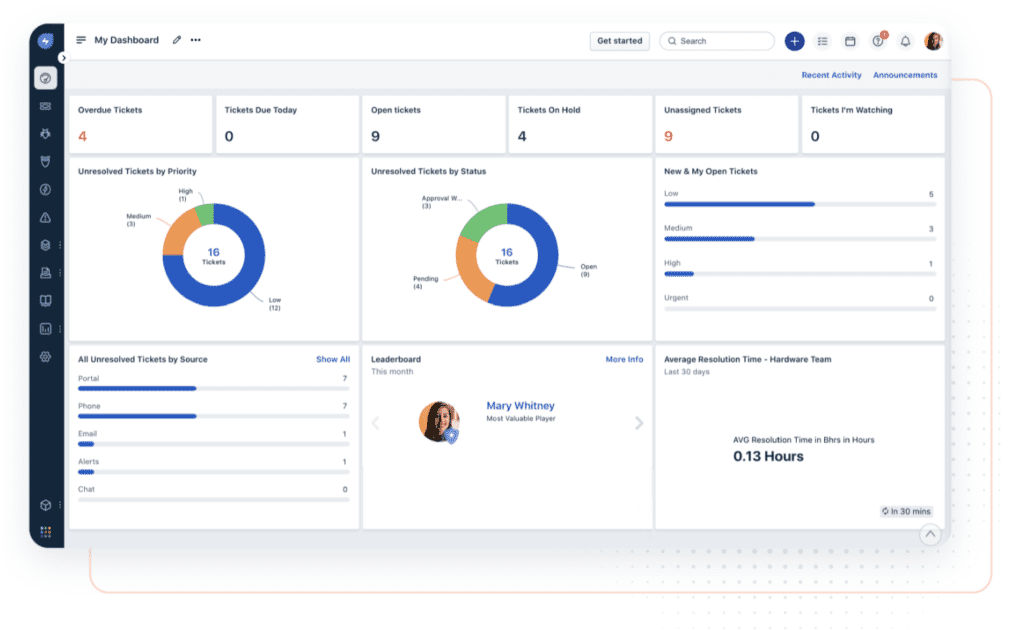
Freshservice by Freshworks helps to modernize IT and other business functions with an easy-to-use, simple-to-configure IT service desk solution in the cloud. It requires no or minimal training. Freshservice comes with multi-channel support and gamification features and has a mobile service desk app.
Key Differentiators
- Incident Management: Freshservice tracks, prioritizes, and assigns tickets and automates resolution processes to drive efficiency.
- Problem Management: Automates tasks and provides support for issues raised via email, self-service portal, phone, chat, or in person.
- Change Management: IT is enabled to plan out and assess changes before they are rolled out.
- Service Asset/Configuration Management: Effective asset management can help avoid duplicity of applications, hardware, hosting, and their support.
- Service Desk: Freshservice resolves tickets raised via multiple channels like email, self-service portal, live chat software, phone, and in person. It also provides visibility into all tickets and tracks their progress via a dashboard.
- Analytics: Freshservice auto-assigns and escalates tickets to the right agents or groups, automatically prioritizes tickets based on impact and urgency, maps relationships to dependencies, and schedules recurring tasks as tickets.
- Extension Beyond IT: Freshservice can be used for IT or non-IT processes.
- Market Strength: The primary market strength lies in SMEs.
- Cost: Freshservice costs $19 per month per agent for small teams and up to $109 per month per agent for the enterprise version.
Microsoft Provance

Provance IT Service Management extends the Microsoft Dynamics 365 platform into the realm of IT service and IT asset management. Provance ITSM leverages all three of the Microsoft clouds (Dynamics 365, Office 365, and Azure), and it is optimized for use with Microsoft management, productivity, and analytic tools. Thus, Provance users can easily leverage existing investments in technology.
Microsoft Provance comes with reporting, a self-service portal with notifications, ticket templates, end-to-end service visibility, automations and business process flows. It is also a PinkVERIFY-certified solution for 11 ITIL processes, so industry best practices are tied in. It is easy to create and modify forms, templates, automations, and business process workflows as needed. It can also leverage PowerApps, Microsoft Flow, and Logic Apps to connect Provance ITSM to other applications without resorting to building something from nothing.
Key Differentiators
- Incident Management: Automated issue escalation and auto routing of incidents and service requests ensure a faster resolution with minimal end-user effort.
- Problem Management: Provance spots trends, analyzes historical information, and identifies key issues, such as the root cause of errors and failures.
- Change Management: You can make changes and modifications without coding and scripting, and the result of changes can be viewed and rolled back if necessary.
- Service Asset/Configuration Management: Cloud Service Management creates a bridge between Provance ITSM and Azure to auto-populate the CMDB, provide a consolidated view of Azure Subscription Schema, deliver real-time online diagnostics and configuration management, and automatically synchronize services.
- Service Desk: The ITSM Service Desk app is an interactive dashboard focused on tickets, with the ability to filter based on variables (such as ticket type, affected services, or priority) and dive deeper into services workload and ticket status information for more effective ticket resolution.
- Analytics: Power BI is used to instantly collect, correlate and aggregate real-time data, spot trends, and analyze historical information.
- Extension Beyond IT: Provance provides quick visualization of the hierarchy between a business service and its technical services.
- Market Strength: Provance’s market strength lies in existing customers of Microsoft Dynamics and Microsoft/Windows technology.
- Cost: A license for Microsoft Dynamics 365 is also required. The Provance IT Service Management User License is $40 per user per month.
This article was updated by IT Business Edge’s Managing Editor Llanor Alleyne.
Read next: How IoT is Shaping ITSM Strategies


